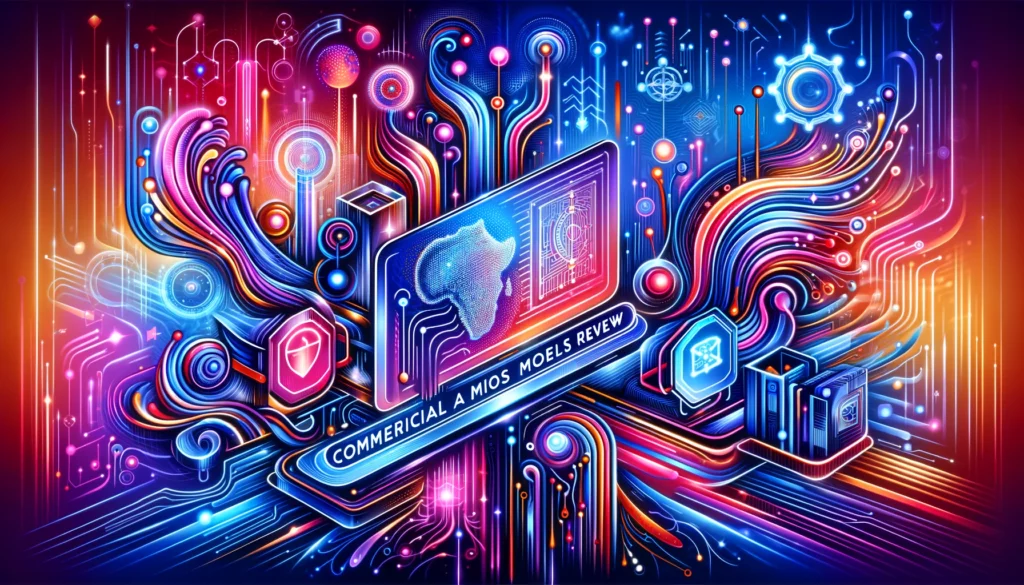Commercial AI Models Review

In today’s ever-changing world of artificial intelligence, the field of commercial AI models stands as a bright spot of innovation and solutions. From chatbots that can handle complex customer inquiries to language models that power virtual assistants, the world of AI is teeming with remarkable possibilities. Here is a comprehensive review, where we’ll explore the technologies shaping our future, their applications, and the transformative impact they have on businesses and industries alike.
Alibaba (Tongyi Qianwen)
In the midst of the fierce AI race engulfing the tech industry, Alibaba, a major player in the field, has unveiled a remarkable advancement in its AI capabilities. The upgraded “Tongyi Qianwen 2.0” model, released by Alibaba’s cloud computing division, showcases a staggering “hundreds of billions of” parameters, a critical benchmark to gauge AI model prowess. This notable achievement firmly positions it among the world’s most potent AI models in terms of this metric.
What’s equally noteworthy is Alibaba’s strategic move to extend its AI influence across specific industry domains. The tech giant has rolled out eight AI models tailored for sectors as diverse as entertainment, finance, healthcare, and law. This swift evolution follows a mere six months after the model’s initial introduction, underscoring the breakneck speed at which tech companies are vying for dominance in China’s burgeoning and rapidly expanding AI landscape.
Alibaba’s ambitious AI endeavors are further underscored by Chairman Joe Tsai’s revelation that nearly half of China’s large-language AI models now find their home on Alibaba Cloud. The company’s AI model-sharing platform, ModelScope, boasts an impressive repository of 2,300 models, all made possible by the contributions of 2.7 million dedicated developers. This multifaceted endeavor highlights Alibaba’s commitment to shaping the future of AI and solidifying its presence in the industry.
Amazon Bedrock
Amazon Bedrock introduces a groundbreaking approach to AI with its fully managed service, presenting a diverse array of high-performing foundation models (FMs) sourced from industry leaders like AI21 Labs, Anthropic, Cohere, Meta, Stability AI, and Amazon, all accessible via a unified API. In addition to this model versatility, it provides a wide range of essential features necessary for the development of generative AI applications, streamlining the development process while upholding stringent standards of privacy and security.
This comprehensive suite of Amazon Bedrock capabilities empowers users to conduct versatile experiments, harnessing multiple top FMs and privately tailoring them to their specific requirements. Techniques such as fine-tuning and retrieval augmented generation (RAG) enable customization, while the creation of managed agents is simplified. These agents are adept at executing intricate business tasks, spanning domains from travel booking and insurance claims processing to ad campaign creation and inventory management, all accomplished without the need for code development.
One remarkable aspect of Amazon Bedrock is its serverless architecture, relieving users of infrastructure management responsibilities. This enables seamless integration and deployment of generative AI capabilities into existing applications using the familiar suite of AWS services, ensuring both convenience and robust security measures.
Ernie Bot
Enhanced Representation through Knowledge Integration,” is a dynamic AI chatbot service developed by Baidu, with a developmental journey that commenced back in 2019. At its core, Ernie Bot harnesses the power of a substantial language model named “Ernie 4.0.” This versatile chatbot is proficient in generating both text and images in response to user queries, offering a range of functionalities.
To access Ernie Bot, interested users can visit the official website or utilize the dedicated app. However, it’s important to note that this app is exclusively available for download via Chinese app stores, aligning with its primary target audience.
Ernie Bot’s appeal extends beyond its technical capabilities, as it has achieved significant recognition in the Chinese Apple store for iOS devices, consistently securing the top position in the rankings of free programs.
Robin Lee, Baidu’s CEO, emphasizes the significance of open access to Ernie Bot, as it serves as a crucial avenue for collecting extensive user feedback. This valuable feedback loop is instrumental in enhancing the foundational models that underpin Ernie and Baidu’s broader AI initiatives, representing a commitment to ongoing refinement and innovation.
Apprentice Bard (Google)
Bard aspires to amalgamate the vast expanse of global knowledge with the cognitive might and creative prowess inherent in our expansive language models. By tapping into the wealth of information on the internet, Bard is adept at furnishing up-to-the-minute, top-tier responses of impeccable quality. More than just an information source, Bard serves as a catalyst for creativity and a springboard for intellectual exploration.
This dynamic tool empowers users to channel their creative energies, making it a platform for artistic expression and a haven for fostering curiosity. It’s a valuable resource that can assist in elucidating intricate concepts, like simplifying the intricate discoveries of NASA’s James Webb Space Telescope for a 10-year-old. Additionally, it can satiate your curiosity by providing in-depth insights into the current roster of top strikers in football. Beyond just information, Bard goes the extra mile by offering practical guidance, such as drills to elevate your skills in the chosen endeavor.
Grok
Upon its initial release, Grok presents itself as a text-based chatbot, a platform that exhibits more constrained functionality when compared to the versatile “multi-modal” AI systems capable of handling various types of media. In contrast to offerings such as Microsoft’s Bing AI and the premium edition of ChatGPT, Grok currently lacks the ability to engage in vocal interactions or generate visual content, including images.
At this juncture, Grok’s access is limited to a curated group of testers, which includes individuals affiliated with Musk’s other ventures, such as SpaceX. This approach serves as a preliminary phase in Grok’s development, marking it as a “very early beta product.” Prior to this external testing phase, the platform has already undergone rigorous internal evaluations, and it is only now that it is undergoing trials with a select group of users, with the ultimate goal of being made available to the general public.
In alignment with the principles of xAI, Grok is intentionally designed to be inclusive and valuable to individuals from diverse backgrounds and with a range of political viewpoints. The company emphasizes its commitment to ensuring that its AI tools empower users within the bounds of applicable laws, underlining its dedication to responsible and ethical use of artificial intelligence.
ChatGPT
Formally known as Chat Generative Pre-trained Transformer, stands as a substantial leap in AI-driven conversation capabilities, crafted by OpenAI. This dynamic chatbot empowers users to steer and fine-tune conversations to meet specific criteria, such as desired length, format, style, level of detail, and language. Each stage of the conversation is meticulously considered, with successive prompts and replies, a technique commonly referred to as prompt engineering, serving as the evolving context.
At its core, ChatGPT operates on the foundation of either GPT-3.5 or GPT-4, integral members of OpenAI’s proprietary series of generative pre-trained transformer (GPT) models. These models are rooted in the transformative transformer architecture pioneered by Google. To harness the immense potential of ChatGPT for conversational applications, it undergoes a fine-tuning process, artfully combining supervised and reinforcement learning techniques.
Originally introduced as a research preview, ChatGPT was offered freely to users, rapidly garnering immense popularity. In response, OpenAI adopted a freemium model for its operation. Users on the free tier have access to the GPT-3.5-based version, while more advanced features are unlocked in the GPT-4-based version and offered to paid subscribers under the banner “ChatGPT Plus.”
As of January 2023, ChatGPT had emerged as one of the swiftest-growing consumer software applications in history, amassing a user base exceeding 100 million and contributing significantly to OpenAI’s valuation, which reached $29 billion. This surge in popularity also ignited the development of competing products, including Bard, Ernie Bot, Claude, and Grok.
Claude
Represents a cutting-edge AI assistant that emerges from Anthropic’s dedicated research into cultivating AI systems that are genuinely helpful, truthful, and innocuous. Accessible through both a chat interface and an API via our developer console, Claude boasts a remarkable array of capabilities for diverse conversational and text processing tasks, all underscored by a commitment to reliability and predictability.
Claude’s versatility extends to a multitude of use cases, ranging from text summarization, efficient search, fostering creativity, facilitating collaborative writing, addressing Q&A scenarios, to even aiding in coding tasks, and beyond. Early adopters of Claude have noted significant advantages, including a reduced propensity for generating harmful or undesirable outputs, enhanced conversational ease, and improved steerability. This means users can achieve their desired results with minimal effort. Claude’s adaptability doesn’t stop there; it is open to receiving guidance on aspects such as personality, tone, and behavioral attributes, further enriching the user experience and output customization.
The evolution of commercial AI models continues to reshape industries and redefine the possibilities of AI-powered solutions. As businesses and researchers go deeper into the capabilities of these models, we witness an ever-accelerating pace of innovation, leading to more sophisticated applications and enhanced user experiences. In this dynamic landscape, the collaboration between technology companies, researchers, and users is at the heart of advancing AI models to new horizons. With the ongoing development of these commercial AI models, we can expect further breakthroughs, setting the stage for an exciting future of AI-driven solutions and services.










